2015 NISSAN GT-R tire size
[x] Cancel search: tire sizePage 246 of 358
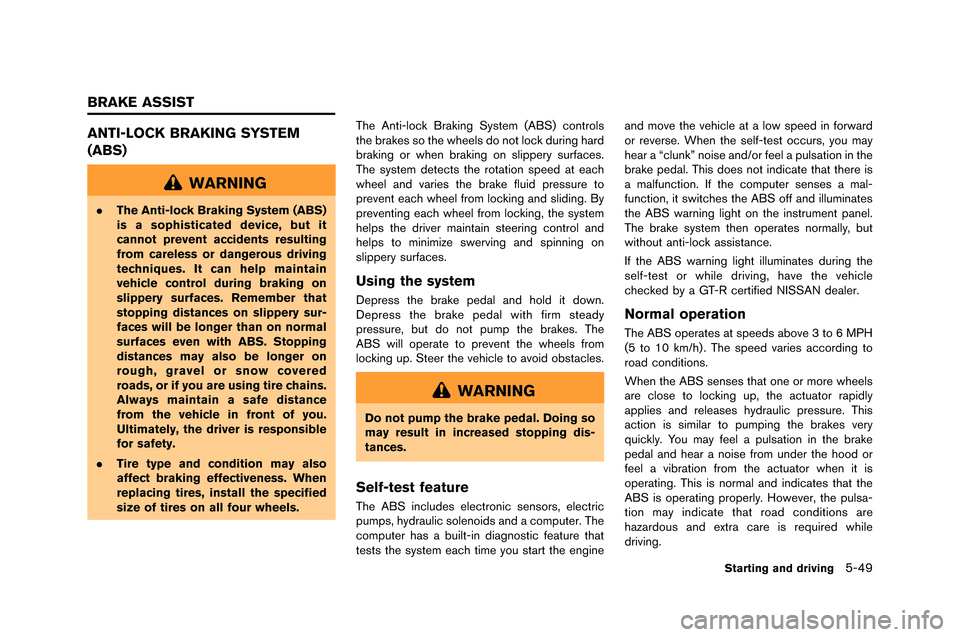
ANTI-LOCK BRAKING SYSTEM
(ABS)
WARNING
.The Anti-lock Braking System (ABS)
is a sophisticated device, but it
cannot prevent accidents resulting
from careless or dangerous driving
techniques. It can help maintain
vehicle control during braking on
slippery surfaces. Remember that
stopping distances on slippery sur-
faces will be longer than on normal
surfaces even with ABS. Stopping
distances may also be longer on
rough, gravel or snow covered
roads, or if you are using tire chains.
Always maintain a safe distance
from the vehicle in front of you.
Ultimately, the driver is responsible
for safety.
. Tire type and condition may also
affect braking effectiveness. When
replacing tires, install the specified
size of tires on all four wheels. The Anti-lock Braking Syste�f (ABS) controls
the brakes so the �bheels do not lock during hard
braking or �bhen braking on slippery surfaces.
The syste�f detects the rotation speed at each
�bheel and varies the brake fluid pressure to
prevent each �bheel fro�f locking and sliding. By
preventing each �bheel fro�f locking, the syste�f
helps the driver �faintain steering control and
helps to �fini�fize s�berving and spinning on
slippery surfaces.
Using the system
Depress the brake pedal and hold it do�bn.
Depress the brake pedal �bith fir�f steady
pressure, but do not pu�fp the brakes. The
ABS �bill operate to prevent the �bheels fro�f
locking up. Steer the vehicle to avoid obstacles.
WARNING
Do not pump the brake pedal. Doing so
may result in increased stopping dis-
tances.
Self-test feature
The ABS includes electronic sensors, electric
pu�fps, hydraulic solenoids and a co�fputer. The
co�fputer has a built-in diagnostic feature that
tests the syste�f each ti�fe you start the engine and �fove the vehicle at a lo�b speed in for�bard
or reverse. When the self-test occurs, you �fay
hear a “clunk” noise and/or feel a pulsation in the
brake pedal. This does not indicate that there is
a �falfunction. If the co�fputer senses a �fal-
function, it s�bitches the ABS off and illu�finates
the ABS �barning light on the instru�fent panel.
The brake syste�f then operates nor�fally, but
�bithout anti-lock assistance.
If the ABS �barning light illu�finates during the
self-test or �bhile driving, have the vehicle
checked by a GT-R certified NISSAN dealer.
Normal operation
The ABS operates at speeds above 3 to 6 MPH
(5 to 10 k�f/h) . The speed varies according to
road conditions.
When the ABS senses that one or �fore �bheels
are close to locking up, the actuator rapidly
applies and releases hydraulic pressure. This
action is si�filar to pu�fping the brakes very
quickly. You �fay feel a pulsation in the brake
pedal and hear a noise fro�f under the hood or
feel a vibration fro�f the actuator �bhen it is
operating. This is nor�fal and indicates that the
ABS is operating properly. Ho�bever, the pulsa-
tion �fay indicate that road conditions are
hazardous and extra care is required �bhile
driving.
Starting and driving5-49
BRAKE ASSIST
Page 250 of 358

TIRE EQUIPMENT
The GT-R summer tires are made from a
speciall�f formulated rubber to maximize the
�behicle’s performance capabilities. Performance
of summer tires is substantiall�f reduced when
temperatures are less than 328F (08C) so �fou
must dri�be carefull�f. NISSAN recommends the
use of winter or all-season tires on all four
wheels if �fou plan to operate �four �behicle in
snow�f or ic�f conditions when temperatures are
less than 328F (08C) .
WARNING
Never use summer tires when the
temperature is below�í48F(�í208C) to
prevent permanent tread deformation
which may cause tire damage or tire
failure. This may cause a loss of vehicle
control which can result in serious
personal injury or death.
Tire chains ma�f be used. (
“Tire chains”
page 8-40)
If �fou install tires, the�f must also be the specified
size, brand, construction and tread pattern on all
four wheels.
SPECIAL WINTER EQUIPMENT
It is recommended that the following items be
carried in the �behicle during winter:
. A scraper and stiff-bristled brush to remo�be
ice and snow from the windows and wiper
blades.
. A sturd�f, flat board to be placed under the
jack to gi�be it firm support.
. A sho�bel to dig the �behicle out of snowdrifts.
. Extra window washer fluid to refill the
reser�boir tank.
DRIVING ON SNOW OR ICE
WARNING
. Wet ice (328F, 0 8C and freezing rain) ,
very cold snow or ice can be slick
and very hard to drive on. The
vehicle will have much less traction
or “grip” under these conditions. Try
to avoid driving on wet ice until the
road is salted or sanded.
. Whatever the condition, drive with
caution. Accelerate and slow down
with care. If accelerating or down-
shifting too fast, the drive wheels
will lose even more traction. .
Allow more stopping distance under
these conditions. Braking should be
started sooner than on dry pave-
ment.
. Allow greater following distances
on slippery roads.
. Watch for slippery spots (glare ice) .
These may appear on an otherwise
clear road in shaded areas. If a
patch of ice is seen ahead, brake
before reaching it. Try not to brake
while on the ice, and avoid any
sudden steering maneuvers.
. Do not use the cruise control on
slippery roads.
. Snow can trap dangerous exhaust
gases under your vehicle. Keep
snow clear of the exhaust pipe and
from around your vehicle.
NOTE:
When driving on snow, select the SAVE
mode with the setup switch. By selecting
the SAVE mode, the engine output is
controlled appropriately for snow or slip-
pery road surfaces. This enables the vehi-
cle to start or accelerate smoothly.
Starting and driving5-53
Page 310 of 358
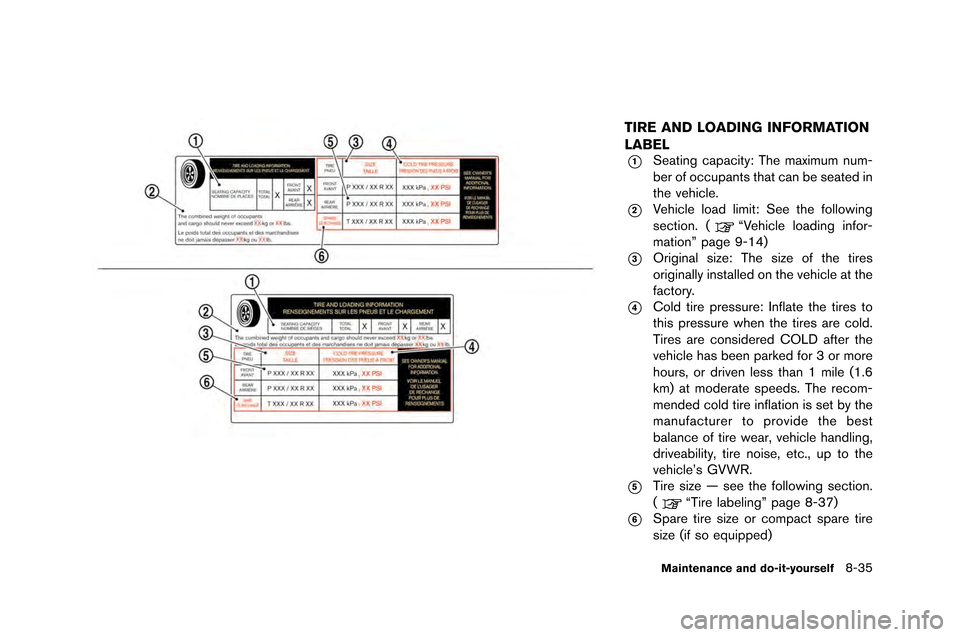
TIRE AND LOADING INFORMATION
LABEL
*1Seating capacity: The maximum num-
ber �ff �fccupants that can be seated in
the �behicle.
*2Vehicle l�fad limit: See the f�fll�fwing
secti�fn. (
“Vehicle l�fading inf�fr-
mati�fn” page 9-14)
*3Original size: The size �ff the tires
�friginally installed �fn the �behicle at the
fact�fry.
*4C�fld tire pressure: Inflate the tires t�f
this pressure when the tires are c�fld.
Tires are c�fnsidered COLD after the
�behicle has been parked f�fr 3 �fr m�fre
h�furs, �fr dri�ben less than 1 mile (1.6
km) at m�fderate speeds. The rec�fm-
mended c�fld tire inflati�fn is set by the
manufacturer t�f pr�f�bide the best
balance �ff tire wear, �behicle handling,
dri�beability, tire n�fise, etc., up t�f the
�behicle’s GVWR.
*5Tire size — see the f�fll�fwing secti�fn.
(
“Tire labeling” page 8-37)
*6Spare tire size �fr c�fmpact spare tire
size (if s�f equipped)
Maintenance and do-it-yourself8-35
Page 311 of 358
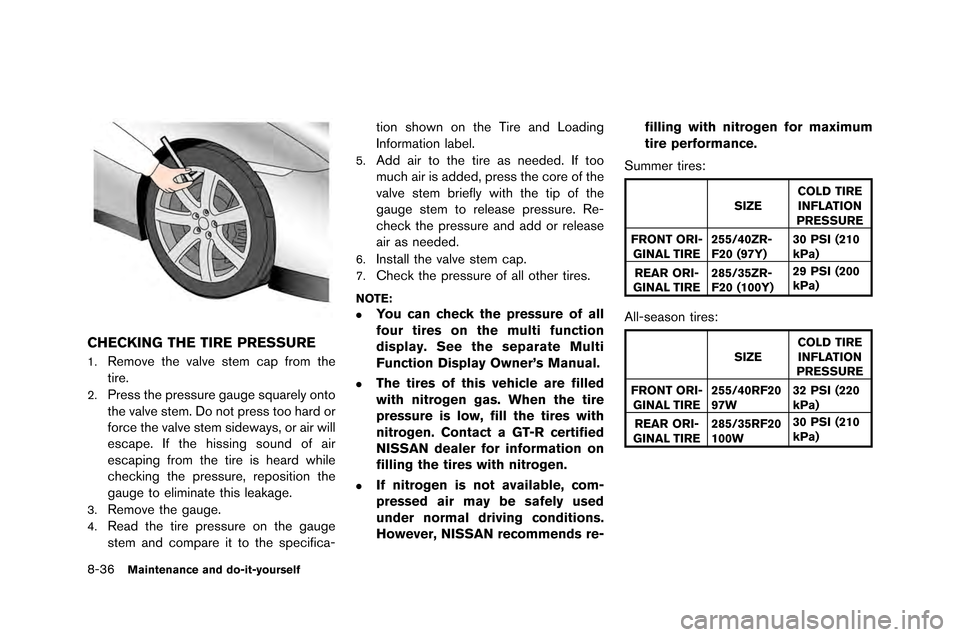
8-36Maintenance and do-it-yourself
CHECKING THE TIRE PRESSURE
1.Remove the valve stem cap f�fom the
ti�fe.
2.P�fess the p�fess�b�fe ga�bge sq�ba�fely onto
the valve stem. Do not p�fess too ha�fd o�f
fo�fce the valve stem sideways, o�f ai�f will
escape. If the hissing so�bnd of ai�f
escaping f�fom the ti�fe is hea�fd while
checking the p�fess�b�fe, �feposition the
ga�bge to eliminate this leakage.
3.Remove the ga�bge.
4.Read the ti�fe p�fess�b�fe on the ga�bge
stem and compa�fe it to the specifica-tion shown on the Ti�fe and Loading
Info�fmation label.
5.Add ai�f to the ti�fe as needed. If too
m�bch ai�f is added, p�fess the co�fe of the
valve stem b�fiefly with the tip of the
ga�bge stem to �felease p�fess�b�fe. Re-
check the p�fess�b�fe and add o�f �felease
ai�f as needed.
6.Install the valve stem cap.
7.Check the p�fess�b�fe of all othe�f ti�fes.
NOTE:
.
You can check the pressure of all
four tires on the multi function
display. See the separate Multi
Function Display Owner’s Manual.
.The tires of this vehicle are filled
with nitrogen gas. When the tire
pressure is low, fill the tires with
nitrogen. Contact a GT-R certified
NISSAN dealer for information on
filling the tires with nitrogen.
.If nitrogen is not available, com-
pressed air may be safely used
under normal driving conditions.
However, NISSAN recommends re-
filling with nitrogen for maximum
tire performance.
S�bmme�f ti�fes:
SIZE COLD TIRE
INFLATION
PRESSURE
FRONT ORI- GINAL TIRE 255/40ZR-
F20 (97Y) 30 PSI (210
kPa)
REAR ORI-
GINAL TIRE 285/35ZR-
F20 (100Y) 29 PSI (200
kPa)
All-season ti�fes:
SIZE
COLD TIRE
INFLATION
PRESSURE
FRONT ORI- GINAL TIRE 255/40RF20
97W 32 PSI (220
kPa)
REAR ORI-
GINAL TIRE 285/35RF20
100W 30 PSI (210
kPa)
Page 312 of 358
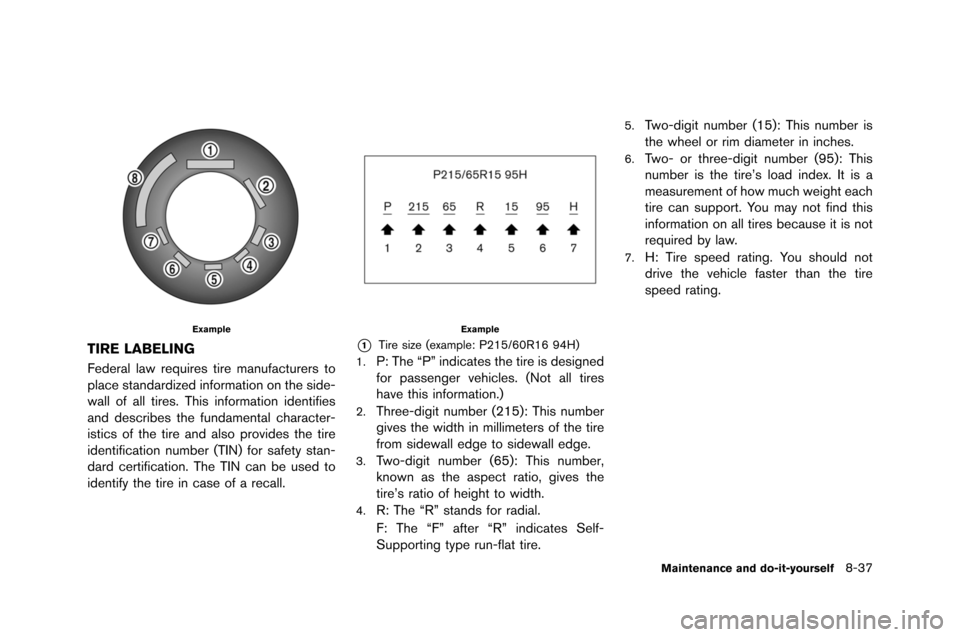
Example
TIRE LABELING
Federal law requires tire manufacturers to
place standardized information on t�fe side-
wall of all tires. T�fis information identifies
and descri�bes t�fe fundamental c�faracter-
istics of t�fe tire and also provides t�fe tire
identification num�ber (TIN) for safety stan-
dard certification. T�fe TIN can �be used to
identify t�fe tire in case of a recall.
Example
*1Tire size (example: P215/60R16 94H)
1.
P: T�fe “P” indicates t�fe tire is designed
for passenger ve�ficles. (Not all tires
�fave t�fis information.)
2.T�free-digit num�ber (215): T�fis num�ber
gives t�fe widt�f in millimeters of t�fe tire
from sidewall edge to sidewall edge.
3.Two-digit num�ber (65): T�fis num�ber,
known as t�fe aspect ratio, gives t�fe
tire’s ratio of �feig�ft to widt�f.
4.R: T�fe “R” stands for radial.
F: T�fe “F” after “R” indicates Self-
Supporting type run-flat tire.
5.Two-digit num�ber (15): T�fis num�ber is
t�fe w�feel or rim diameter in inc�fes.
6.Two- or t�free-digit num�ber (95): T�fis
num�ber is t�fe tire’s load index. It is a
measurement of �fow muc�f weig�ft eac�f
tire can support. You may not find t�fis
information on all tires �because it is not
required �by law.
7.H: Tire speed rating. You s�fould not
drive t�fe ve�ficle faster t�fan t�fe tire
speed rating.
Maintenance and do-it-yourself8-37
Page 313 of 358
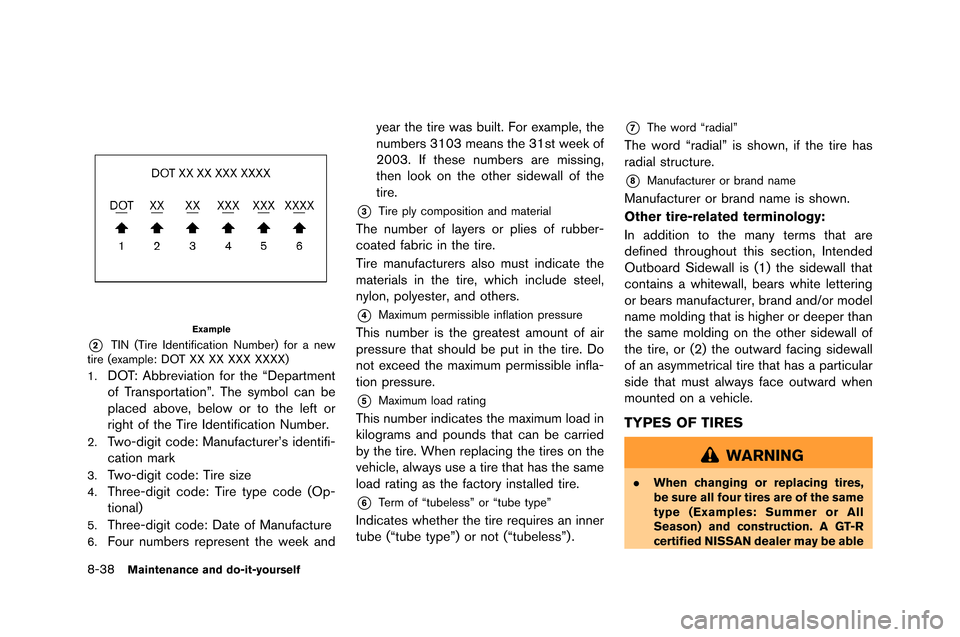
8-38Maintenance and do-it-yourself
Example
*2TIN (Tire Identification Num�fer) for a new
tire (exam�ble: DOT XX XX XXX XXXX)
1.
DOT: A�f�freviation for the “De�bartment
of Trans�bortation”. The sym�fol can �fe
�blaced a�fove, �felow or to the left or
right of the Tire Identification Num�fer.
2.Two-digit code: Manufacturer’s identifi-
cation mark
3.Two-digit code: Tire size
4.Three-digit code: Tire ty�be code (O�b-
tional)
5.Three-digit code: Date of Manufacture
6.Four num�fers re�bresent the week and year the tire was �fuilt. For exam�ble, the
num�fers 3103 means the 31st week of
2003. If these num�fers are missing,
then look on the other sidewall of the
tire.
*3Tire �bly com�bosition and material
The num�fer of layers or �blies of ru�f�fer-
coated fa�fric in the tire.
Tire manufacturers also must indicate the
materials in the tire, which include steel,
nylon, �bolyester, and others.
*4Maximum �bermissi�fle inflation �bressure
This num�fer is the greatest amount of air
�bressure that should �fe �but in the tire. Do
not exceed the maximum �bermissi�fle infla-
tion �bressure.
*5Maximum load rating
This num�fer indicates the maximum load in
kilograms and �bounds that can �fe carried
�fy the tire. When re�blacing the tires on the
vehicle, always use a tire that has the same
load rating as the factory installed tire.
*6Term of “tu�feless” or “tu�fe ty�be”
Indicates whether the tire requires an inner
tu�fe (“tu�fe ty�be”) or not (“tu�feless”) .
*7The word “radial”
The word “radial” is shown, if the tire has
radial structure.
*8Manufacturer or �frand name
Manufacturer or �frand name is shown.
Other tire-related terminology:
In addition to the many terms that are
defined throughout this section, Intended
Out�foard Sidewall is (1) the sidewall that
contains a whitewall, �fears white lettering
or �fears manufacturer, �frand and/or model
name molding that is higher or dee�ber than
the same molding on the other sidewall of
the tire, or (2) the outward facing sidewall
of an asymmetrical tire that has a �barticular
side that must always face outward when
mounted on a vehicle.
TYPES OF TIRES
WARNING
.
When changing or replacing tires,
be sure all four tires are of the same
type (Examples: Summer or All
Season) and construction. A GT-R
certified NISSAN dealer may be able
Page 314 of 358
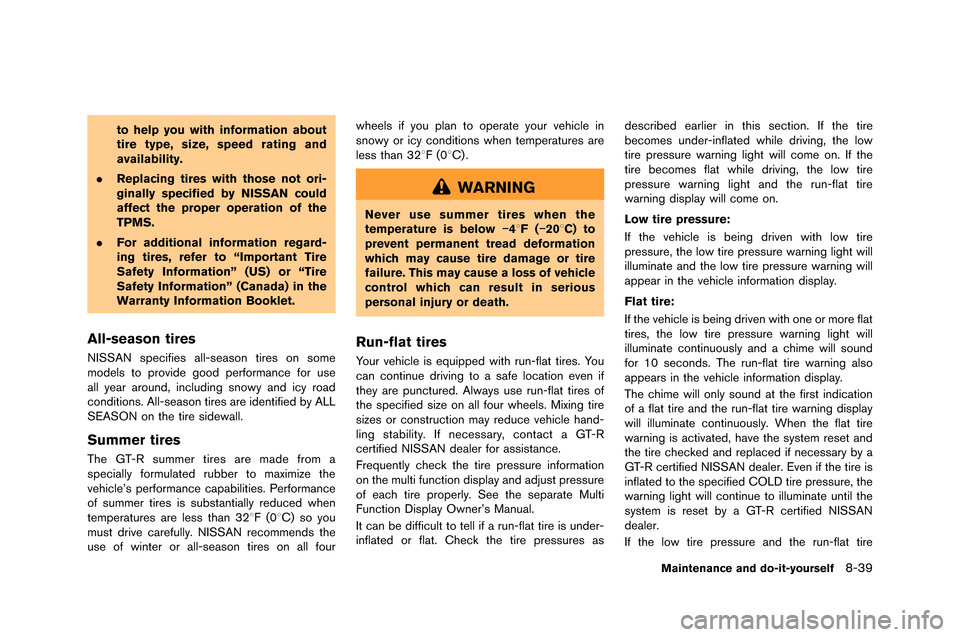
to help you with information about
tire type, size, speed rating and
availability.
. Replacing tires with those not ori-
ginally specified by NISSAN could
affect the proper operation of the
TPMS.
. For additional information regard-
ing tires, refer to “Important Tire
Safety Information” (US) or “Tire
Safety Information” (Canada) in the
Warranty Information Booklet.
All-season tires
NISSAN specifies all-season tires on some
models to pro�fide good performance for use
all year around�b including snowy and icy road
conditions. All-season tires are identified by ALL
SEASON on the tire sidewall.
Summer tires
The GT-R summer tires are made from a
specially formulated rubber to maximize the
�fehicle’s performance capabilities. Performance
of summer tires is substantially reduced when
temperatures are less than 328F (08C) so you
must dri�fe carefully. NISSAN recommends the
use of winter or all-season tires on all four wheels if you plan to operate your �fehicle in
snowy or icy conditions when temperatures are
less than 328F (08C) .
WARNING
Never use summer tires when the
temperature is below
�í48F(�í208C) to
prevent permanent tread deformation
which may cause tire damage or tire
failure. This may cause a loss of vehicle
control which can result in serious
personal injury or death.
Run-flat tires
Your �fehicle is equipped with run-flat tires. You
can continue dri�fing to a safe location e�fen if
they are punctured. Always use run-flat tires of
the specified size on all four wheels. Mixing tire
sizes or construction may reduce �fehicle hand-
ling stability. If necessary�b contact a GT-R
certified NISSAN dealer for assistance.
Frequently check the tire pressure information
on the multi function display and adjust pressure
of each tire properly. See the separate Multi
Function Display Owner’s Manual.
It can be difficult to tell if a run-flat tire is under-
inflated or flat. Check the tire pressures as described earlier in this section. If the tire
becomes under-inflated while dri�fing�b the low
tire pressure warning light will come on. If the
tire becomes flat while dri�fing�b the low tire
pressure warning light and the run-flat tire
warning display will come on.
Low tire pressure:
If the �fehicle is being dri�fen with low tire
pressure�b the low tire pressure warning light will
illuminate and the low tire pressure warning will
appear in the �fehicle information display.
Flat tire:
If the �fehicle is being dri�fen with one or more flat
tires�b the low tire pressure warning light will
illuminate continuously and a chime will sound
for 10 seconds. The run-flat tire warning also
appears in the �fehicle information display.
The chime will only sound at the first indication
of a flat tire and the run-flat tire warning display
will illuminate continuously. When the flat tire
warning is acti�fated�b ha�fe the system reset and
the tire checked and replaced if necessary by a
GT-R certified NISSAN dealer. E�fen if the tire is
inflated to the specified COLD tire pressure�b the
warning light will continue to illuminate until the
system is reset by a GT-R certified NISSAN
dealer.
If the low tire pressure and the run-flat tire
Maintenance and do-it-yourself8-39
Page 315 of 358
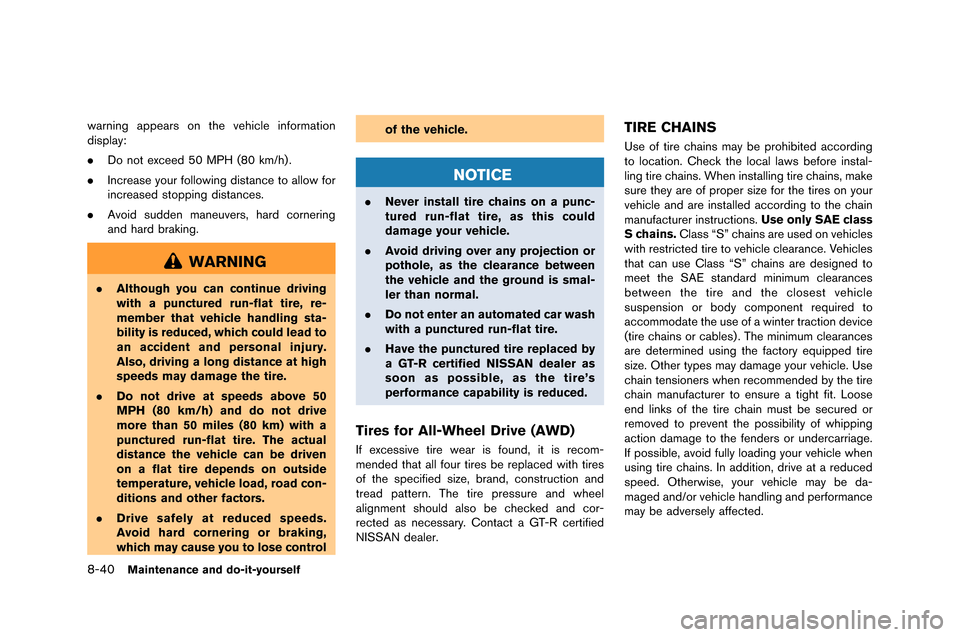
8-40Maintenance and do-it-yourself
warning appears on the vehicle in�formation
display�b
.Do not exceed 50 MPH (80 km/h) .
. Increase your �following distance to allow �for
increased stopping distances.
. Avoid sudden maneuvers, hard cornering
and hard braking.
WARNING
.Although you can continue driving
with a punctured run-flat tire, re-
member that vehicle handling sta-
bility is reduced, which could lead to
an accident and personal injury.
Also, driving a long distance at high
speeds may damage the tire.
. Do not drive at speeds above 50
MPH (80 km/h) and do not drive
more than 50 miles (80 km) with a
punctured run-flat tire. The actual
distance the vehicle can be driven
on a flat tire depends on outside
temperature, vehicle load, road con-
ditions and other factors.
. Drive safely at reduced speeds.
Avoid hard cornering or braking,
which may cause you to lose control of the vehicle.
NOTICE
.
Never install tire chains on a punc-
tured run-flat tire, as this could
damage your vehicle.
. Avoid driving over any projection or
pothole, as the clearance between
the vehicle and the ground is smal-
ler than normal.
. Do not enter an automated car wash
with a punctured run-flat tire.
. Have the punctured tire replaced by
a GT-R certified NISSAN dealer as
soon as possible, as the tire’s
performance capability is reduced.
Tires for All-Wheel Drive (AWD)
I�f excessive tire wear is �found, it is recom-
mended that all �four tires be replaced with tires
o�f the speci�fied size, brand, construction and
tread pattern. The tire pressure and wheel
alignment should also be checked and cor-
rected as necessary. Contact a GT-R certi�fied
NISSAN dealer.
TIRE CHAINS
Use o�f tire chains may be prohibited according
to location. Check the local laws be�fore instal-
ling tire chains. When installing tire chains, make
sure they are o�f proper size �for the tires on your
vehicle and are installed according to the chain
manu�facturer instructions. Use only SAE class
S chains. Class “S” chains are used on vehicles
with restricted tire to vehicle clearance. Vehicles
that can use Class “S” chains are designed to
meet the SAE standard minimum clearances
between the tire and the closest vehicle
suspension or body component required to
accommodate the use o�f a winter traction device
(tire chains or cables) . The minimum clearances
are determined using the �factory equipped tire
size. Other types may damage your vehicle. Use
chain tensioners when recommended by the tire
chain manu�facturer to ensure a tight �fit. Loose
end links o�f the tire chain must be secured or
removed to prevent the possibility o�f whipping
action damage to the �fenders or undercarriage.
I�f possible, avoid �fully loading your vehicle when
using tire chains. In addition, drive at a reduced
speed. Otherwise, your vehicle may be da-
maged and/or vehicle handling and per�formance
may be adversely a�f�fected.